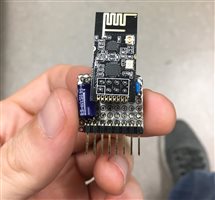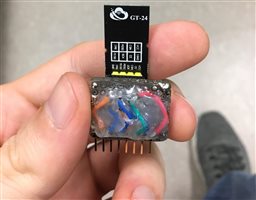Hi, I'm trying to use SPI to control an RF module to send audio data from one microcontroller to another. The parts and software I'm working with are:
- NRF52 Development Kit
- SDK 14.2.0
- NRF24L01+ Module
- NRF24 library for Arduino using SPI (https://github.com/martinbudden/NRF24)
I need one NRF52 to control an NRF24L01+ to act as a transmitter sending data and the other acting as a receiver; these roles will never need to change and this will be the only NRF24L01+ pair for this project. I've edited the NRF24 libraries from Github to use Nordic's functions instead of Arduino's to avoid having to include everything Arduino (changed delay(#) to nrf_delay_ms(#), using nrf SPI driver instead of Arduino's SPI, etc.). I am having problems getting the two devices to actually communicate with one another despite getting them to (seemingly) work on their own individually. The transmitter says it is transmitting, the receiver says it is waiting to receive, so I believe the initialization to be incorrect on one or both ends. For now all I care about is getting any data across and I can handle getting it up to speed and sending audio files later.
Strange things I've noticed thus far:
- SPI with the NRF24L01+ only seems to work at 1Mbps
- In order to not get garbage over SPI I needed to send a NOP first during initialization and then proceed as normal
- Datasheet mentions the contents of the STATUS register are sent out whenever SS goes from high to low, seemed to be fixed by condensing as many SPI commands into single transmissions instead of using separate enable/ disable commands for the GPIO
- Writing over the default address in either receive data pipes 0 or 1 did not seem to change their values, they output the same before and after (0xE7E7E7E7E7 for data pipe 0 and 0xC2C2C2C2C2 for data pipe 1).
Here's the print outs I'm getting from my receiver and transmitter test code so far (the data is all in hex with SPI's MOSI in the left column and MISO in the right column):
RECEIVER Init FF 00 Config setup 20 07 02 0E RF setup 26 07 08 00 Set channel to #1 25 0E 01 00 Set Rx Mode 20 0E 03 00 27 0E 70 00 read address pipe line 1 0B 0E FF C2 FF C2 FF C2 FF C2 FF C2 address: C2 C2 C2 C2 C2 writing address hopefully 2B 0E 41 07 6C 07 6D 07 61 07 6F 07 read address again 0B 07 41 C2 6C C2 6D C2 61 C2 6F C2 address: C2 C2 C2 C2 C2 read payload if available 17 0E FF 11 read payload if available 17 0E FF 11
TRANSMITTER Init FF 00 Config setup 20 07 02 2E RF setup 26 07 08 00 Set channel to #1 25 2E 01 00 Flush TX E1 2E Write payload A0 07 4E 2E 6F 00 72 00 64 00 69 00 63 00 00 00 Set to TX mode 20 07 02 00 27 2E 70 00 Flush TX E1 2E Write payload A0 07 4E 2E 6F 00 72 00 64 00 69 00 63 00 00 00 Set to TX mode 20 07 02 00 27 2E 70 00 Flush TX E1 2E
I'm initializing SPI with:
static const nrf_drv_spi_t spi = NRF_DRV_SPI_INSTANCE(SPI_INSTANCE);
/* ... */
void spi_init()
{
nrf_drv_spi_config_t spi_config = NRF_DRV_SPI_DEFAULT_CONFIG;
spi_config.ss_pin = SPI_SS_PIN;
spi_config.miso_pin = SPI_MISO_PIN;
spi_config.mosi_pin = SPI_MOSI_PIN;
spi_config.sck_pin = SPI_SCK_PIN;
spi_config.frequency = NRF_DRV_SPI_FREQ_1M;
APP_ERROR_CHECK(nrf_drv_spi_init(&spi, &spi_config, spi_event_handler, NULL));
}
Are there any libraries or methods I could be using to more easily interface with the NRF24L01+'s than reusing an Arduino library? I'm going to continue experimenting with SPI commands, timings, ordering, and initialization to see if I can get it working on my own for the time being unless I can find something better.


